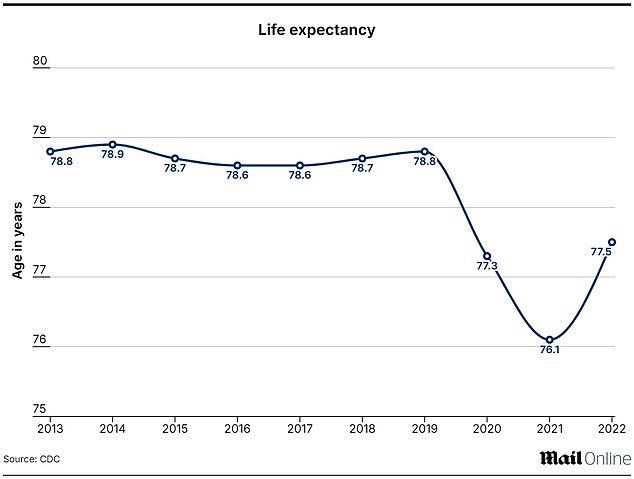After years of decline, Americans’ health appears to be on the upswing.
The US has historically been behind its peers when it comes to rates of chronic conditions, addiction, diseases and lifespan, despite allocating the highest share of its national income to health expenditures.
But new data from the CDC and other leading health agencies shows a number of health markers are beginning to improve – including cancer mortality, drug overdoses, obesity rates and life expectancy.
Experts attribute the declines of the three former to increased screenings, improved treatments, access to drug treatment and medications and the use of weight-loss drugs.
And it is because of the declines in those aspects that Americans’ lifespans may be on the rise.
LONGER LIVES
It may be because of the improvements in obesity, cancer mortality and drug deaths that life expectancy appears to have slightly increased.
In 2022, lifespan at birth was estimated to be 77.5 years. This was an increase from 76.1 years in 2021, but still lower than a decade ago when it was 78.8 years, according to CDC data.
Death rates fell among all age groups, but infant mortality rose.
A driving force behind the rise could be a decline in Covid deaths. Before the pandemic in 2019, lifespan was 78.8, but that dropped in 2020 to 77.3 and again in 2021 to 76.1.
A shift in attitudes and behavior regarding drinking and drugs may also be behind the rise.
A 2023 Gallup poll found a record-high 39 percent of Americans said consuming one to two drinks per day is bad for their health, an 11-percentage-point increase from five years earlier.
Additionally, the poll found 76 percent of Americans said cigarettes and 54 percent said vapes were very harmful to a person’s health.
While on the upswing, the US life expectancy is still behind many of its peers. In the UK, life expectancy is 82 years; in France and Italy it is 83 years; in Spain it is 84; and the average across the European Union is 81.5 years at birth.
FEWER DRUG DEATHS


The above map shows the percent change in drug overdoses state-by-state from the year beginning April 2023 and ending April 2024
Preliminary data shows drug overdoses fell 12 percent nationally from April 2023 (112,470 deaths) to April 2024 (97,309 deaths).
This is the lowest number of deaths since February 2021, but still more than double from nearly a decade ago.
Major strides in drug epidemic were made in North Carolina, where deaths fell 23 percent and Nebraska, where deaths dropped by 30 percent.
But Alaska and Oregon saw large increases in overdose deaths, with increases of 42 percent and 22 percent, respectively.
Nearly all drugs tracked by the CDC saw declines in overdoses. Year-over-year from April 2023 to April 2024, 1,830 fewer people died from cocaine; 1,719 fewer died from heroin; and 12,123 fewer died from opioids.
While experts haven’t come to a consensus on what is driving the decline, some believe it is because of the increased availability of life-saving Narcan, which can reverse certain overdoses, and increased education and public awareness of the dangers of fentanyl.
However, others have posited deaths are declining simply because the fentanyl crisis has been so catastrophic it’s run out of people to kill.
BEATING CANCER

Another encouraging trend is the decline in cancer deaths.
The death rate from cancers has been on a downward trend since 2015, decreasing from 160 deaths per 100,000 cancer patients to 142 deaths per 100,000 patients in 2022.
This is the lowest rate in cancer deaths in a decade, when the rate was 164 deaths in 2013, according to the National Cancer Institute. Between 2013 and 2022, death rates have been falling an average of 1.7 percent each year.
And the average five-year survival rate for cancer has been on the rise. According to the American Cancer Society, the rate was 69 percent between 2013 and 2019, an increase from 49 percent in 1977.
Survival rates are highest for thyroid cancer (99 percent), prostate cancer (97 percent) and testicular cancer (95 percent).
The lowest rates are for pancreatic (13 percent), liver and esophagus (22 percent) and lung (25 percent). However, all of these cancers have seen an increase in survival from 1977 when rates were three percent for pancreatic and liver, five percent for esophagus and 12 percent for lung.
The ACS attributes the rise in five-year rates to improved cancer screenings, which lead to earlier detection when the disease is more treatable. Additionally, advancements in treatments and therapies, especially in immunotherapy, have helped bolster survival rates.
In general, cancer incidence rates have also declined, though breast and colon cancers have seen a rise, especially in diagnoses among young people.
SLIMMER WAISTLINES

A recent CDC report found American adults with obesity also appear to be falling, decreasing from nearly 42 percent in 2020 to 40.3 percent in 2021.
This is the first time there has been a year-over-year decrease since the CDC began regularly tracking the metric in 2013, though the change is not statistically significant.
However, experts say it could be a sign obesity rates will no longer be on the rise.
The decline comes amid a boom of weight-loss drugs like Wegovy and Ozempic, though experts have previously told DailyMail.com it’s still too early to know if the medications are playing a role.
Despite the slight drop, rates are still higher than they were a decade ago when approximately 38 percent of adults had obesity.
